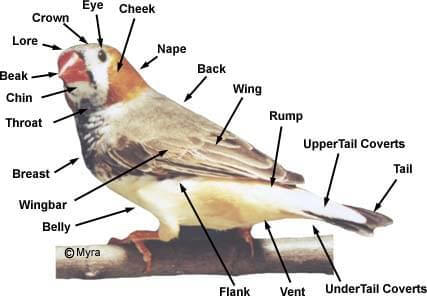Parts of a Finch
..a red headed, blue back, purple breasted what??
by Myra
Articles and Information - Lady Gouldian Finch
You look at a finch and see a small bird. It's pretty; color here, color there, a beak and a tail. We learned the basic external structures from school when we were kids. Beak, tail, eye, wing, foot, leg, head, back, and so on. The basics alone are plenty for most people, there's no need to learn any of the specific areas and their proper names. Unless, of course, you plan to breed mutations or show birds as a profession or hobby. Just what is what on a finch and why is it so important to learn them?
We'll start at the top and work our way around the body..
 Zebra Finch with parts identified
Zebra Finch with parts identified
Lore: This is the area around the nostrils or just behind it. In the Zebra finch and in most domestic finches the lore isn't referenced often. However if you are into wild bird watching or breeding Softbills it does help to know where this structure is.
Crown: The top of the head. In crested finches and Parrots, the crown is also the crest area.
Cheek: Also known as the Ear Patch in some wild birds and Softbills. It's often only referred to as the cheek if there is a specific markings to look for in that area (example: red-cheeked cordon bleu). In the photo shown above of the Black Breast mutation of the Zebra finch, the cheek markings extend around to the back of the head.
Nape: The Yellow Naped Amazon always springs to mind when I hear the nape referred to. The nape is really just the area at the base of the head or the neck. Most finches don't have nape specific markings but several Parrots, and Softbills do.
Back: A basic structure but referred to when talking about the Saddle Backed Pied Zebra or Light Backed Zebra.
Wing: Another simple one.
Rump: Not the butt, as most people think. The rump is where the topside of the tail meets the body. The species Rosey-Rumped Waxbill, for example, will have a soft red color in this rump area, it's a distinguishing feature.
Upper Tail Coverts: My photo doesn't show these well. If you've seen a Grey Zebra, and noticed the 2 to 3 semi-long feathers on the tail that show the black and white zebra stripes, you've seen the upper tail coverts. These coverts aren't always very long and they form a bridge between the rump and the tail.
Tail: Another one from the good old school days. Tails may be short and stubby, long and powerful, or fancy and purely decoration but they are always called the tail.
Undertail Coverts: Just like the upper tail coverts only on the underside. :)
Vent: Here's the butt. It also refers to the feathers and their special coloring (if there is any) around the vent opening.
Flank: A popular term among zebra finch breeders. The flanks are located on each side of the body and just below each wing. Again I will apologize for the photo. This particular bird doesn't show his flanks well at all.
Belly: Fairly forthright, it's the area below the breast , between the legs, and above the vent. A rather large area in fact.
Wingbar: The long feathers on the wing are the primary flight feathers, the shorter ones just above those are the Wingbar area. The term wingbar is almost always used to describe an area of color only. If we were talking about the actual feathers they would be greater primary and secondary coverts.
Breast: This one is easy. It's that round area below the bird's head. In the Zebra Finch the Breast bar is easy to spot. It's solid black in most mutations. Even Owl finches have a thin black bar that runs across the base of the breast.
Throat: It's really the entire area between the chin and the breast. Long-tail Grassfinches have a wonderful black bib pattern that covers the throat area and sometimes touches the top of the breast area.
Chin: Right below the lower half of the beak there is a little chin area. Chins aren't commonly referred to when talking about finches but some Softbill and Parrot species have little tufts of feathers in this spot.
Beak: The beat is a very prominent feature on any bird. You can get a rough idea of a bird?s basic diet simply by looking at the shape of its beak. Some birds have simple beaks, others have fancy shapes and colors, all serve their purpose.
There are more specific structures on a bird such as the different types of feathers on the wing, tail, and body but I'm not going to go into that much detail. This is simply to give you a better understanding of what breeders and show judges are talking about when reviewing various species of birds.
© lady gouldian finch.com 2017